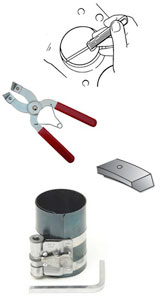Here are 10 brief pointers from Hastings Piston Rings on how to properly install piston rings and avoid a comeback.

1. Insert rings squarely into the bore and measure end gap with feeler gauge;
2. Adjust gap if needed by filing both sides of gap equally;
3. Use ring expander tool to install rings on piston, so as not deform ring – do not spiral on rings;
4. Install directional rings with the dot up (otherwise oil pumping may occur);
5. Install 2.0mm 3-piece oil ring with expander points up to avoid catching in drain-back hole/slot in oil groove bottom;
6. Stagger location of end gaps on each ring 180 degrees apart;
7. Clean bores with hot soapy water & scrub brush, wipe with clean white rag to check for any residue;
8. Lightly oil cylinder walls and rings with regular non-synthetic motor oil;
9. Properly tighten ring compressor so rings don’t catch on edge of cylinder or pop out in bore (don’t force piston if it is hung up);
10. Typical engine break-in: use conventional motor oil – change oil after first 3,000 miles. Use only synthetic motor oil if originally specified by manufacturer.
Source: Hastings Piston Rings.













